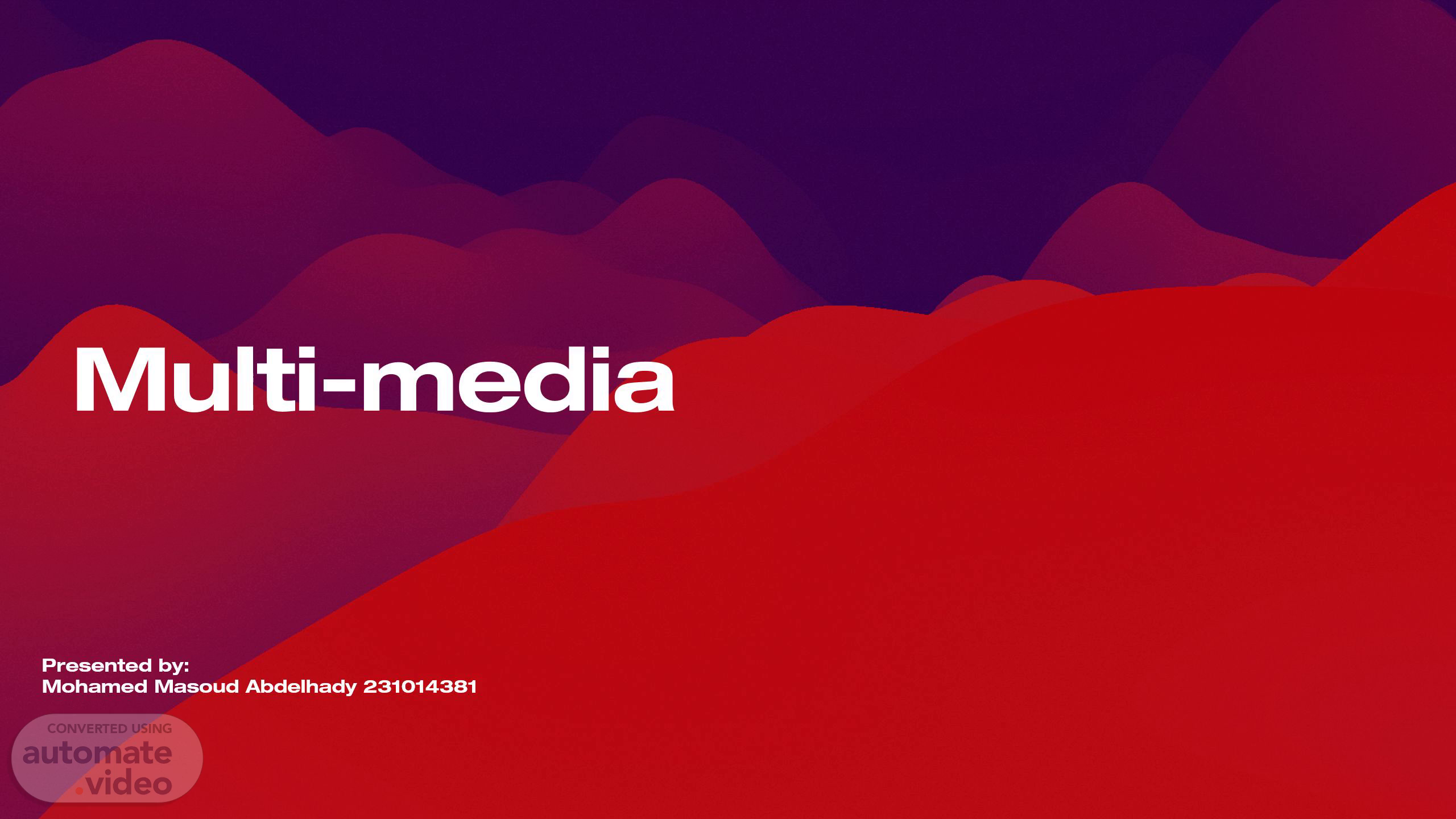Scene 1 (0s)
Presented by: Mohamed Masoud Abdelhady 231014381.
Scene 2 (7s)
What Is Color Theory?. • A system of rules for mixing and using colors • Goals: Aesthetic mixtures, clarity, cultural meaning.
Scene 3 (17s)
Types of Color Theories. Additive Theory (Light) : deal with radiated and filtered light Subtractive Theory (Pigment) : deal with how white light is absorbed and reflected off of colored surfaces.
Scene 4 (28s)
Additive Color Theory. Primary colors: Red, Green, Blue Used in: TV, theater, computer monitors Primary color are added together to give white light Sun radiate all light.
Scene 5 (41s)
Subtractive Color Theory. Primary colors: Cyan, Magenta, Yellow Used in: Printing, painting Black color absorb most light white color reflects most light Colored pigments absorb light and reflect only the frequency of the pigment color.
Scene 6 (54s)
Color Schemes Overview. There are 4 commonly used color schemes : RGB Color Scheme CMY or CMYK Color Scheme HSB or HSI (Hue, Saturation, Brightness/Intensity) Color Scheme YUV Color Scheme.
Scene 7 (1m 6s)
RGB Color Scheme. Any color can be defined by giving its R, G and B values, or coordinates, (red, green, blue). Colors are represented by a numeric triplet specifying R, G and B Computer monitors display colors by emitting color dots (red, green, blue)..
Scene 8 (1m 21s)
CMY/CMYK Color Scheme. CMYK (Cyan, Magenta, Yellow, Black) scheme is widely used for color printing. Color is specified by what is subtracted from white light. Cyan, magenta, and yellow are the subtractive primaries and are the complements of red, green and blue..
Scene 9 (1m 38s)
HSB/HSI color scheme. hue is dominant color of a sample and is represented by an angular value saturation purity of the color brightness is intensity of the color.
Scene 10 (1m 49s)
HSB/HSI color scheme. Hue is the color sensation produced in an observer due to the presence of certain wavelengths of color. Each wavelength presents a different hue. Hue is based on a vector value moving from 0 to 360 degrees on a color wheel..
Scene 11 (2m 3s)
HSB/HSI color scheme. Saturation is a measure of color intensity Example: the difference between red and pink..
Scene 12 (2m 13s)
HSB/HSI color scheme. Intensity / Luminance or Brightness is a measure of the light emitted or reflected by an object. Certain colors appear brighter than others as the human eye does not respond in the same way to all colors..
Scene 13 (2m 27s)
HSB/HSI color scheme. Saturation: Intensity or purity of a color Brightness: Light emitted or reflected Eyes perceive brightness better than color.
Scene 14 (2m 37s)
YUV Color Scheme. This is the basic color format used by composite color TV standards Y represents the luminance/brightness and can be thought of as containing black and white or gray-scale information U and V carry the chrominance or color information..
Scene 15 (2m 51s)
YUV Color Scheme. The advantage of using YUV for broadcast : is that the amount of data needed to define a television picture is greatly reduced. The disadvantage : is that many colors that appear on a computer display cannot be recreated on TV.
Scene 16 (3m 5s)
Color Palettes. Palettes are mathematical tables that define the color of a pixel displayed on the screen. Paint programs provide a palette tools for displaying available colors not uniform across programs or platforms Color graphics adaptors work with 256 shades of each color producing over 16 million colors.
Scene 17 (3m 20s)
Palette Flashing Problem. It a serious problem in multimedia. Palette Flashing occurs when you use a series of images each with its own color palette. Solution : Use a single palette for all project images.
Scene 18 (3m 32s)
Color Wheel. Complementary and opposite colors in the wheel provide the most visual contrast. Contrast: noticeable level of difference between two colors. The wheel can describe colors by: Hue (* Tone): degrees from 0˚ to 360˚. Saturation: brightness or dullness. Value: lightness or darkness..
Scene 19 (3m 48s)
Color Wheel – Saturation. Saturation is the intensity of a color. A highly saturated color is bright and appears closer to the edge of the wheel. A more unsaturated color is dull. A color with no saturation is achromatic or in the grey scale..
Scene 20 (4m 2s)
Color Wheel – Value. Lightness/darkness Controls visual contrast.
Scene 21 (4m 9s)
Color in Text & Background. Text should be readable Contrast between text and background is important Avoid red-green, red-blue, magenta-green combinations which cause vibration and eye fatigue. Dark text on light background or one with high brightness and low saturation is best..
Scene 22 (4m 25s)
Contrast with Text. The more a color contrasts with the colors around it, the more easily visible that color will appear.
Scene 23 (4m 34s)
Verbal Color Contrast. Use contrast to draw attention Design prioritization through color.
Scene 24 (4m 42s)
Practical Example – Flyers. Orange vs. blue text boxes the orange box above provides a nice contrast with the blues and grays of the clothes rack. The blue box is too similar to the clothes’ color palette..
Scene 25 (4m 55s)
Dithering. Dithering is a process where the color value of each pixel changes to the closest matching color value in the target palette Dithering software is usually built into image editing and multimedia programs.
Scene 26 (5m 8s)
Color Dithering. Color Dithering : the process through which colors are changed to meet the closest available color based on the available palette..
Scene 27 (5m 18s)
Color Harmony Schemes. Certain combinations of colors tend to be pleasing. They arise from the color harmony schemes: Monochromatic Complementary Warm Cool.
Scene 28 (5m 28s)
THANK YOU.
